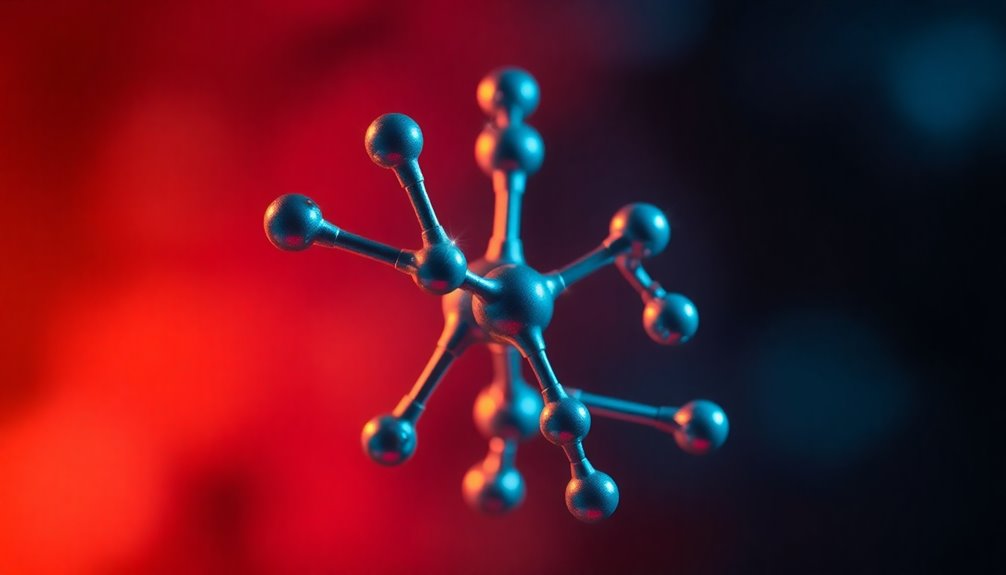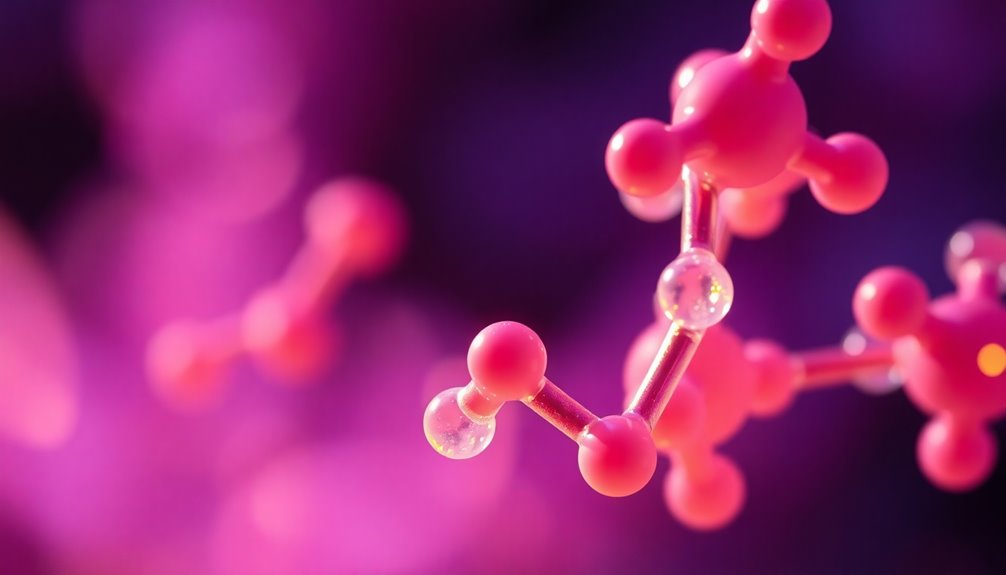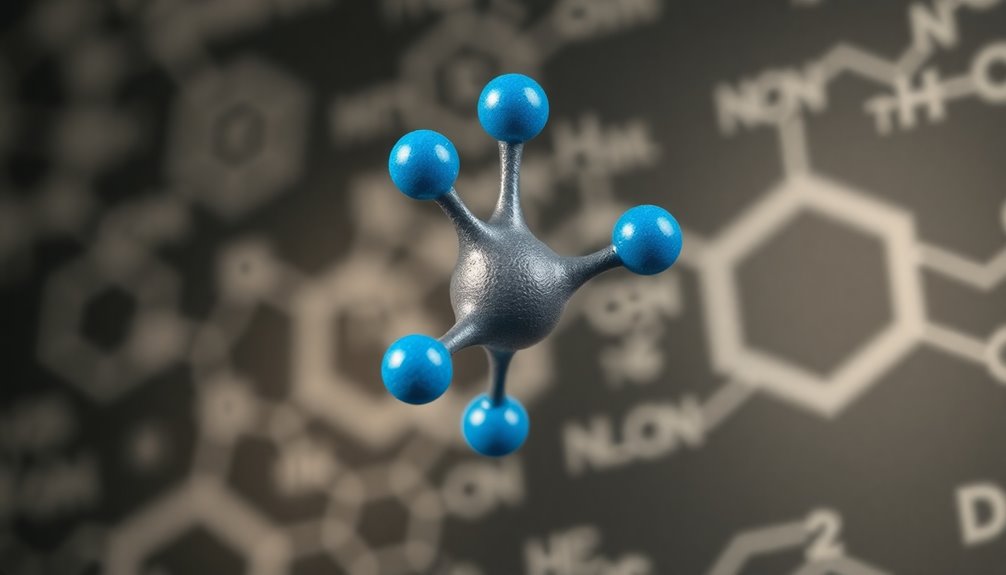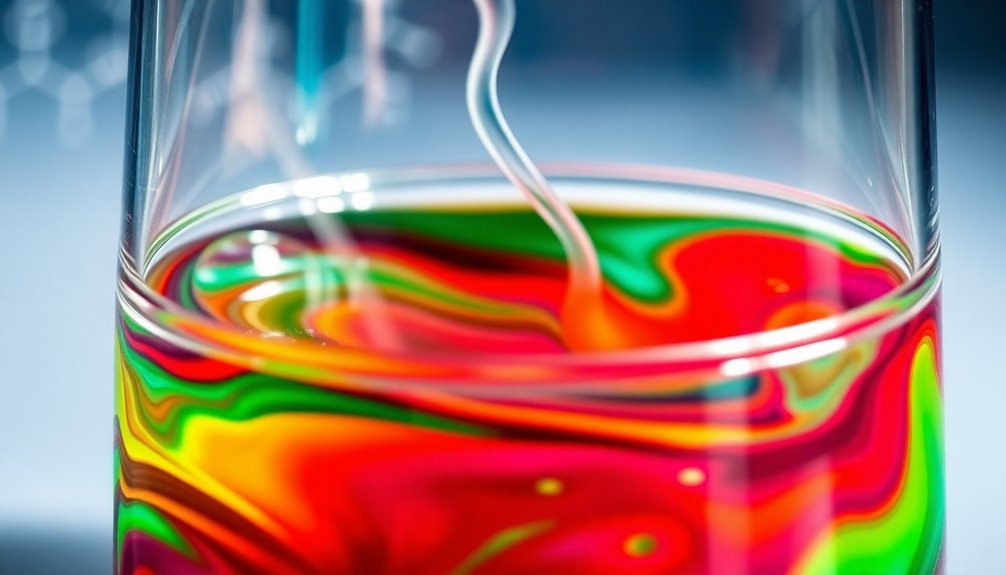Histidine isn't fully aromatic, but it does exhibit partial aromaticity due to its imidazole ring. This structure allows for resonance, making histidine important in biochemical processes. It stabilizes enzymes and facilitates proton transfer, which is essential for many reactions. Knowing that histidine plays a dual role as both an acid and a base helps you appreciate its significance in enzyme function. Understanding these properties is critical for MCAT preparation, especially when tackling amino acids and enzyme mechanisms. Stick around, and you'll discover more about its unique characteristics and why they matter in biochemical contexts.
Key Takeaways
- Histidine contains an imidazole ring that exhibits partial aromaticity due to resonance and six pi electrons.
- It meets Hückel's rule for aromatic compounds, contributing to its stability and reactivity.
- Histidine's pKa of approximately 6.0 allows it to function effectively as an acid or base.
- The imidazole side chain is crucial for enzymatic reactions, enhancing proton transfer and substrate binding.
- Understanding histidine's aromaticity is important for MCAT preparation, particularly in enzyme mechanisms and amino acid properties.
Histidine's Structure and Properties

Histidine's unique structure sets it apart from other amino acids, primarily due to its imidazole ring. This basic amino acid features an imidazole ring that allows it to participate in resonance, enhancing its reactivity and stability in enzymatic functions.
Its pKa is approximately 6.0, which is close to physiological pH of around 7.4. This proximity enables histidine to act as both an acid and a base, making it versatile in biological systems.
The aromatic nature of the imidazole ring also facilitates essential interactions within enzyme active sites, promoting catalysis through its ability to be protonated or deprotonated. These properties underscore histidine's importance in various biochemical processes, particularly in protein structure and function.
Aromaticity Explained

Histidine's imidazole ring plays an essential role in its aromaticity, which is vital for its biochemical functions.
You'll see how the ring meets aromaticity criteria, such as Huckel's rule, and how tautomerization impacts histidine's reactivity.
Understanding these concepts helps clarify histidine's importance in enzymatic processes and protein interactions.
Histidine's Imidazole Ring
The imidazole ring in histidine is a fascinating structure that contributes considerably to its aromatic properties. This five-membered heterocyclic ring has two nitrogen atoms, which allow it to participate in resonance, enabling electron delocalization. This characteristic is essential for understanding aromatic compounds.
Regarding amino acids, histidine stands out because it can exist in both protonated and deprotonated forms due to its pKa of about 6.0. This flexibility enhances its reactivity and makes it important in enzyme active sites, where it facilitates acid/base catalysis during biochemical reactions.
Aromaticity Criteria in Biochemistry
When exploring the concept of aromaticity in biochemistry, it's vital to understand the specific criteria that define an aromatic compound. A compound must meet Huckel's rule, which requires a planar structure and a cyclic system of conjugated pi electrons totaling 4n + 2, where n is a non-negative integer.
Histidine fits the bill with its imidazole ring, containing two nitrogen atoms and six pi electrons, thereby satisfying the aromaticity criteria. The imidazole ring allows for resonance, enabling electron delocalization that enhances stability and aromatic character.
These properties are significant in enzyme active sites, as they facilitate acid-base catalysis. However, histidine's basicity is influenced by its pKa of about 6.0, allowing it to be protonated or deprotonated near physiological pH.
Tautomerization and Reactivity
Understanding tautomerization in histidine reveals how its imidazole ring contributes to its reactivity and functional versatility in biochemical processes. The imidazole ring's aromaticity, with its 6 pi electron system, allows for resonance stabilization, which enhances histidine's reactivity.
Here are some key points to reflect on:
- Histidine mainly exists in the n1 tautomer form due to resonance stabilization.
- The positioning of hydrogen atoms affects its acid-base catalysis capabilities.
- These properties play a significant role in enzymatic reactions, especially in active sites.
- Histidine's aromatic characteristics help stabilize intermediary states during enzyme-catalyzed reactions.
Histidine in Biochemical Reactions

Histidine plays an essential role in biochemical reactions, especially in enzymatic catalysis.
Its imidazole ring allows you to see how it can easily switch between protonated and deprotonated states, making it effective at physiological pH.
Understanding this dynamic is key to grasping how histidine influences reaction mechanisms and stabilizes transformation states.
Histidine's Role in Catalysis
The imidazole side chain of histidine plays a fundamental role in biochemical catalysis. Its unique properties enable histidine to participate actively in enzymatic reactions, contributing to efficiency and specificity.
Here's how it works:
- Acid-Base Catalysis: Histidine can act as both an acid and a base due to its pKa of around 6.0.
- Active Site Presence: It often occupies active sites in enzymes, enhancing substrate binding.
- Proton Transfer: Its ability to be protonated or deprotonated facilitates significant proton transfers during reactions.
- Stabilizing Transition States: Histidine's reactivity helps stabilize transition states, improving overall catalytic performance.
Protonation and Reaction Mechanisms
While exploring protonation and reaction mechanisms, you'll find that histidine's imidazole ring is pivotal in many biochemical reactions.
Its aromatic structure, with six pi electrons, enhances reactivity, particularly in enzymatic active sites. Histidine's pKa of around 6.0 allows it to participate in acid-base catalysis effectively, making it a key player in stabilizing transformation states.
Near physiological pH, it can easily toggle between protonated and deprotonated states, influencing substrate interactions and enzyme functionality.
Additionally, tautomerization introduces different resonance forms, impacting histidine's reactivity and interactions in various environments.
This unique ability to adapt to changing pH levels underscores histidine's importance in biochemical processes, ensuring efficient catalytic activity in a wide range of reactions.
Importance in Enzyme Function

When considering the importance of amino acids in enzyme function, histidine stands out due to its unique imidazole ring. This structure allows histidine to play a vital role in many enzymatic reactions. Its pKa, close to physiological pH, enables it to easily switch between protonated and deprotonated states, enhancing its catalytic capabilities.
Here are some key points about histidine in enzyme function:
- Participates in acid-base catalysis, essential for many active sites.
- Acts as both a proton donor and acceptor in reactions.
- Stabilizes intermediate states, aiding substrate conversion.
- Essential for the function of various enzymes, like proteases.
Histidine's unique properties make it indispensable in biochemical processes, contributing greatly to enzyme efficiency.
MCAT Relevance and Preparation

How does histidine's unique structure impact its significance on the MCAT? Histidine's imidazole ring features 6 pi electrons, classifying it as aromatic, and making it a key focus in amino acid property questions.
With a pKa around 6.0, histidine can readily be protonated or deprotonated near physiological pH, which is essential for understanding its enzymatic roles.
Its aromatic nature allows for resonance participation, important in acid-base catalysis—a frequent topic in the biochemistry section.
You'll likely encounter questions about how histidine's unique reactivity influences enzyme mechanisms.
Community Perspectives on Histidine

Why is histidine such a hot topic among MCAT students? Its unique aromatic imidazole ring sparks debates on its classification, making it vital for your exam prep. Understanding histidine's structure and reactivity is essential, as it plays pivotal roles in enzymatic reactions.
Here's what the community emphasizes:
- Histidine's aromatic characteristics are key for mastering complex questions.
- Its ability to exist in different tautomeric forms can change a reaction's outcome.
- Many students share resources to clarify histidine's classification, addressing conflicting study materials.
- Engaging in discussions helps reinforce your grasp of histidine's properties for effective MCAT preparation.
These insights won't only enhance your knowledge but also boost your confidence when tackling related MCAT questions.
Frequently Asked Questions
Is Histidine Aromatic for MCAT?
When you consider histidine's structure, you'll see it has an imidazole ring, which makes it aromatic.
This ring allows for electron delocalization, giving histidine unique chemical properties.
You might note that its pKa is around 6.0, enabling it to act as both an acid and a base.
Understanding histidine's aromaticity is vital, especially since it plays a significant role in enzymatic reactions and biological systems where proton transfer occurs.
Is Histidine Aromatic or Not?
Think of histidine as a chameleon, adept at changing its role in biochemical environments.
Yes, histidine is aromatic, thanks to its imidazole ring, which boasts six pi electrons and resonance stability.
This aromatic structure enhances histidine's unique reactivity, allowing it to function as an acid-base catalyst.
Its pKa value of around 6.0 means it can toggle between protonated and deprotonated forms, making it essential for enzymatic reactions in proteins.
Which Amino Acids Are Aromatic in MCAT?
When you're preparing for the MCAT, you'll want to focus on three key aromatic amino acids: phenylalanine, tyrosine, and tryptophan.
Each of these has a unique ring structure that defines its aromatic properties.
Phenylalanine is nonpolar, tyrosine is polar due to its hydroxyl group, and tryptophan features an indole ring.
Understanding their roles in protein structure and function will help you tackle related questions effectively during your exam.
Is Histidine Acidic or Basic Mcat?
You might think all amino acids fit neatly into the categories of acidic or basic, but histidine's unique nature complicates that.
With a pKa around 6.0, it sits right at the physiological pH, meaning it can act as both an acid and a base. This versatility allows histidine to participate actively in biochemical reactions.
Conclusion
To summarize, histidine's unique structure blends seamlessly with its role in biochemical reactions, much like a puzzle piece fitting perfectly into a larger picture. While it isn't classified as aromatic, its importance in enzyme function can't be overlooked. As you prepare for the MCAT, think of histidine as a bridge between concepts—connecting amino acid properties with real-world applications. Embrace its nuances, and you'll be ready to tackle questions with confidence.










